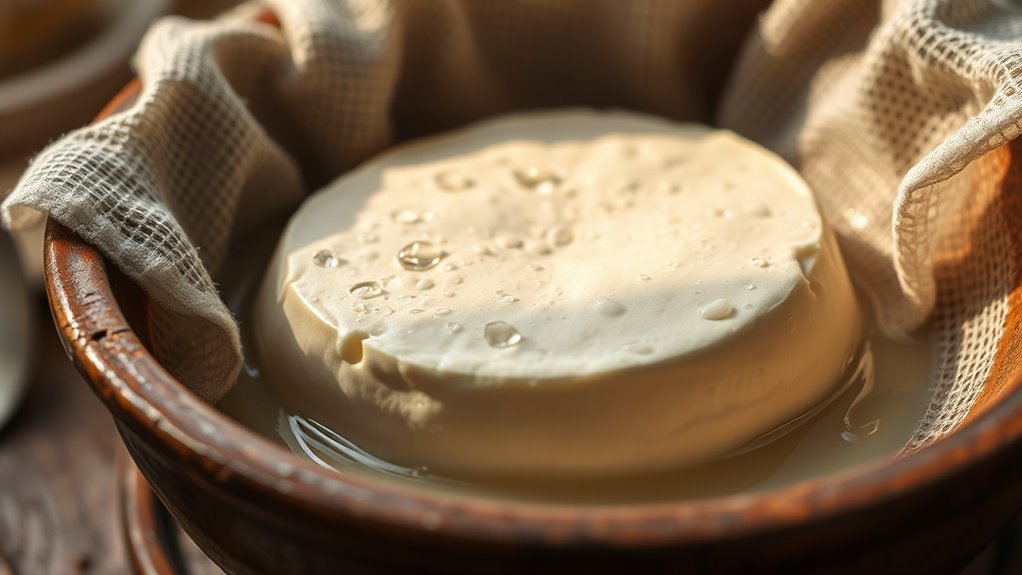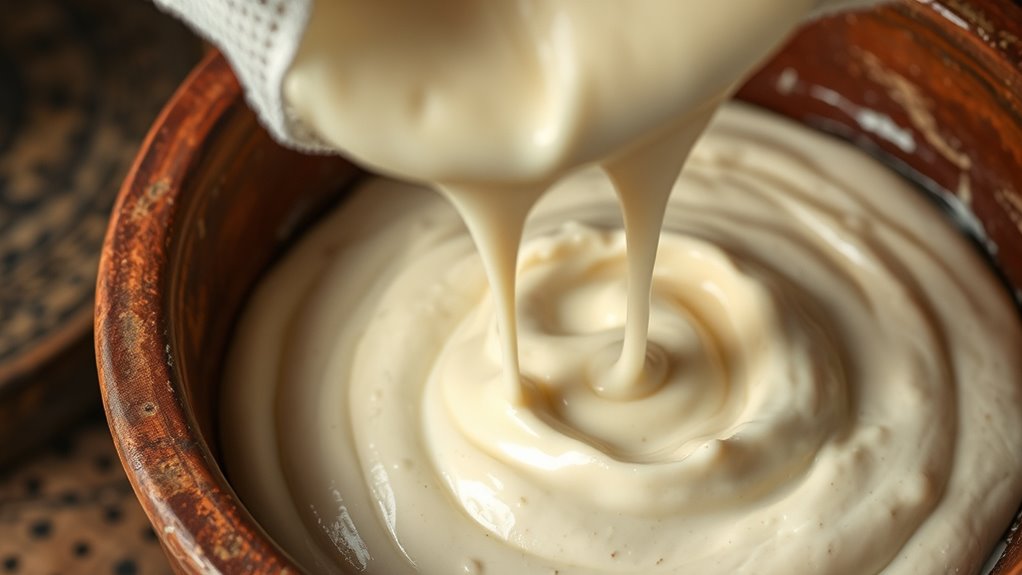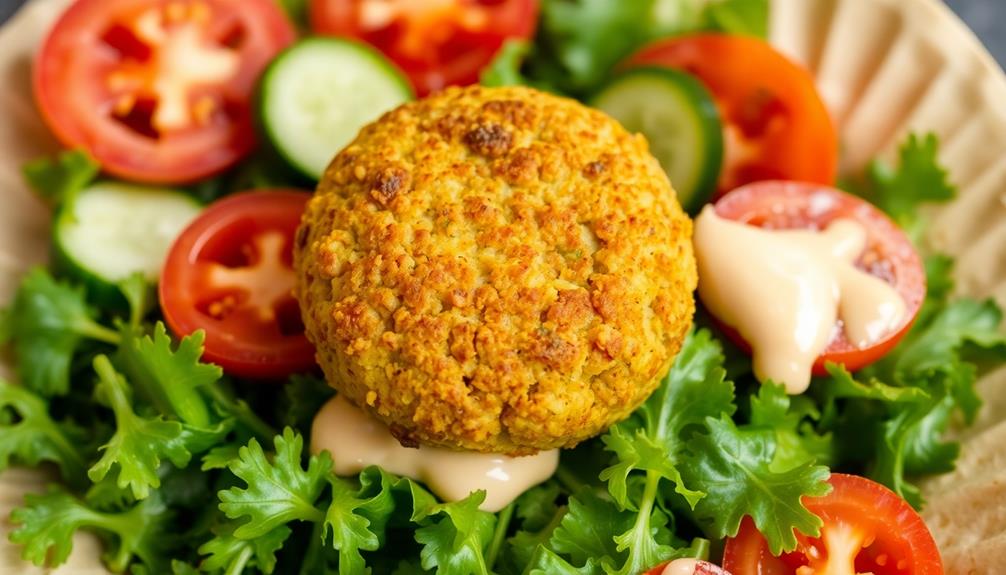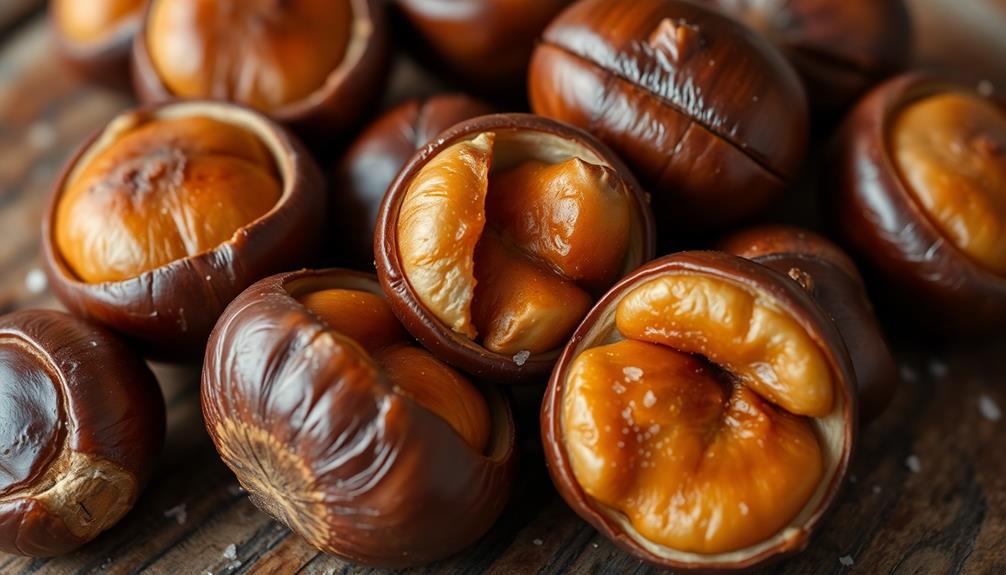To control the creaminess of Lebanese labneh, monitor whey drainage carefully—usually between 12 to 24 hours at room temperature—using cheesecloth or fine mesh. Drain longer for a thicker, denser spread, but avoid over-drying, which can make it crumbly. Adjust drainage time based on your desired texture, balancing richness with moisture. If you want to master the perfect consistency, there’s more to explore about fermentation and flavor control.
Key Takeaways
- Drain whey for 12-24 hours at room temperature to achieve desired creaminess; longer drainage yields thicker, denser labneh.
- Adjust drainage time based on texture preference: shorter for creamier, longer for firmer consistency.
- Use cheesecloth or fine mesh to control whey removal efficiently and prevent over-drying.
- Monitoring texture during drainage helps avoid dryness or excess moisture, ensuring optimal creaminess.
- Proper fermentation duration enhances flavor without over-souring, complementing whey drainage control for ideal texture.

Labneh is a popular Middle Eastern dairy spread known for its thick, creamy texture and tangy flavor. Achieving the perfect consistency and flavor involves understanding the fermentation process and how to control whey drainage. When you start making labneh, you’re essentially fermenting strained yogurt, which creates its characteristic tang and develops depth in flavor. This fermentation process is vital because it influences not only taste but also texture. The longer you allow the yogurt to ferment, the more pronounced the tang becomes, but too long can make the labneh overly sour. Finding a balance ensures you get the desired flavor enhancement without overpowering the creamy base.
Controlling whey drainage plays a key role in determining labneh’s final texture. As whey drains from the yogurt, the remaining solids become thicker and creamier. If you drain too quickly or for too long, you risk ending up with a dense, dry spread. Conversely, insufficient drainage results in a runny or overly moist product. To manage this, you can use cheesecloth or a fine mesh strainer, adjusting the drainage time based on your preferred creaminess. Typically, draining for 12 to 24 hours at room temperature yields a rich, smooth consistency. If you want a thicker, more robust labneh, extend the drainage period slightly, but always keep an eye on the texture to avoid over-drying. Drainage time is a crucial factor in achieving the ideal consistency. Additionally, using appropriate drainage materials can influence the efficiency and outcome of the process. Monitoring temperature during fermentation can help control the fermentation process, ensuring optimal flavor development.
Flavor enhancement through fermentation is subtle but impactful. As the yogurt ferments, natural bacteria produce lactic acid, which intensifies the tanginess and adds complexity to the flavor profile. You can influence this process by adjusting fermentation conditions—warmer temperatures speed it up, while cooler environments slow it down. Incorporating herbs or spices during the fermentation or after draining can also elevate the flavor, giving your labneh a personalized touch. Proper fermentation control ensures a balanced tang and depth of flavor that aligns with your preferences. Remember, patience is key; a well-fermented labneh will have a balanced tang, silky texture, and a depth of flavor that’s hard to achieve with quick methods.
Frequently Asked Questions
How Does Climate Affect Labneh’s Drainage Rate?
Climate impact directly influences your labneh’s drainage speed. Warm, humid conditions slow whey drainage because moisture retention increases, making the labneh creamier and less firm. Conversely, cooler, drier weather accelerates drainage, resulting in a thicker, firmer texture. You should adjust your draining time based on the climate, as it affects how quickly whey escapes and ultimately determines the creaminess and consistency of your labneh.
Can Additives Alter the Creaminess of Labneh?
You might wonder if additives can influence labneh’s creaminess. The additive effects are significant; they allow you to manipulate creaminess to suit your preference. By adding ingredients like cream, yogurt, or thickeners, you can enhance the texture and achieve your ideal consistency. These adjustments give you control over creaminess, making your labneh richer or lighter depending on your desired outcome, providing a versatile way to customize your dairy product.
What’s the Ideal Storage Temperature for Homemade Labneh?
You should store your homemade labneh at a temperature between 1-4°C (34-39°F). Keeping it within this range slows down microbial growth, ensuring it stays fresh longer and maintains quality. If the storage temperature gets too high, bacteria can thrive, causing spoilage. For best results, use a clean, airtight container and monitor your fridge’s temperature regularly to preserve the creamy texture and freshness of your labneh.
How Long Can Labneh Be Stored Without Spoilage?
Think of your labneh as a delicate flower; it needs proper care to stay fresh. Typically, you can keep homemade labneh in the fridge for about 7 to 10 days. To prevent spoilage, store it in an airtight container and keep it chilled at or below 4°C. Proper storage extends its shelf life and helps you enjoy its creamy goodness without worry. Always check for sour smell or mold before eating.
Are There Health Benefits Linked to Whey Drainage Levels?
You might wonder if whey drainage levels in labneh offer health benefits. Higher drainage typically means less whey, which can concentrate nutrients, providing better nutritional advantages. It may also improve digestion since the reduced whey content can make the product easier to digest for some people. So, adjusting drainage levels not only affects creaminess but can also enhance overall health benefits, making your labneh both tastier and more beneficial.
Conclusion
As you perfect your labneh, you’ll notice that whey drainage and creaminess often seem to improve just when you least expect it. Sometimes, a simple change in draining time or temperature makes all the difference. It’s almost like the cheese knows when you’re about to give up and surprises you with the perfect texture. Keep experimenting—you might find that the key to your ideal labneh appears just as you’re about to move on.










